Medication Administration and Handling: An In-depth Exploration
VerifiedAdded on 2023/06/13
|31
|6828
|160
Homework Assignment
AI Summary
This assignment provides a comprehensive overview of medication administration and handling, covering various essential aspects within the healthcare domain. It delves into the administration of intravenous (IV) medications by enrolled nurses, highlighting the necessary qualifications and guidelines. The assignment also explores continuing professional development for nurses and midwives, emphasizing the importance of preventing healthcare-associated infections. Furthermore, it discusses the Phlebitis assessment tool, drug schedules, pharmacodynamics, pharmacokinetics, and pharmacotherapeutics, differentiating between toxicology, adverse reactions, and anaphylactic reactions. Contraindications, precautions, and side effects of medications are also examined, along with potential reactions during blood transfusions and the 'rights' of medication administration. The assignment further explains various routes of medication administration, including buccal, metered dose inhalers, spacer inhalers, nasogastric tubes, nasal sprays, and vaginal medications, and different types of IV infusions. It also touches on factors affecting medicine handling, acidifiers, alkalisers, diuretics, and replacement therapies for fluid and electrolyte imbalance, as well as the use of nitrous oxide and desflurane as anesthetics, omeprazole as an antacid, and nitroglycerin as an antianginal. Lorazepam is also mentioned as an example medication.
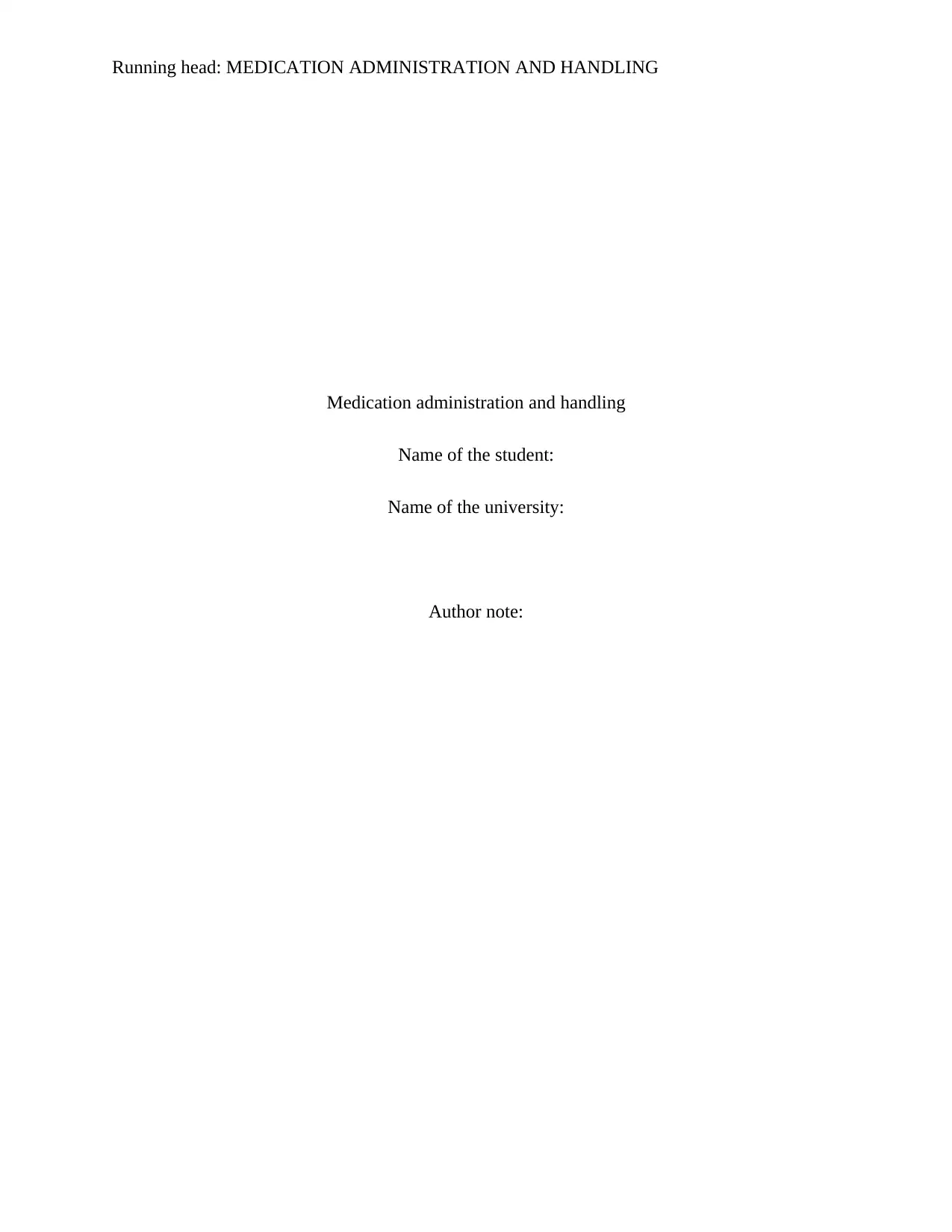
Running head: MEDICATION ADMINISTRATION AND HANDLING
Medication administration and handling
Name of the student:
Name of the university:
Author note:
Medication administration and handling
Name of the student:
Name of the university:
Author note:
Paraphrase This Document
Need a fresh take? Get an instant paraphrase of this document with our AI Paraphraser
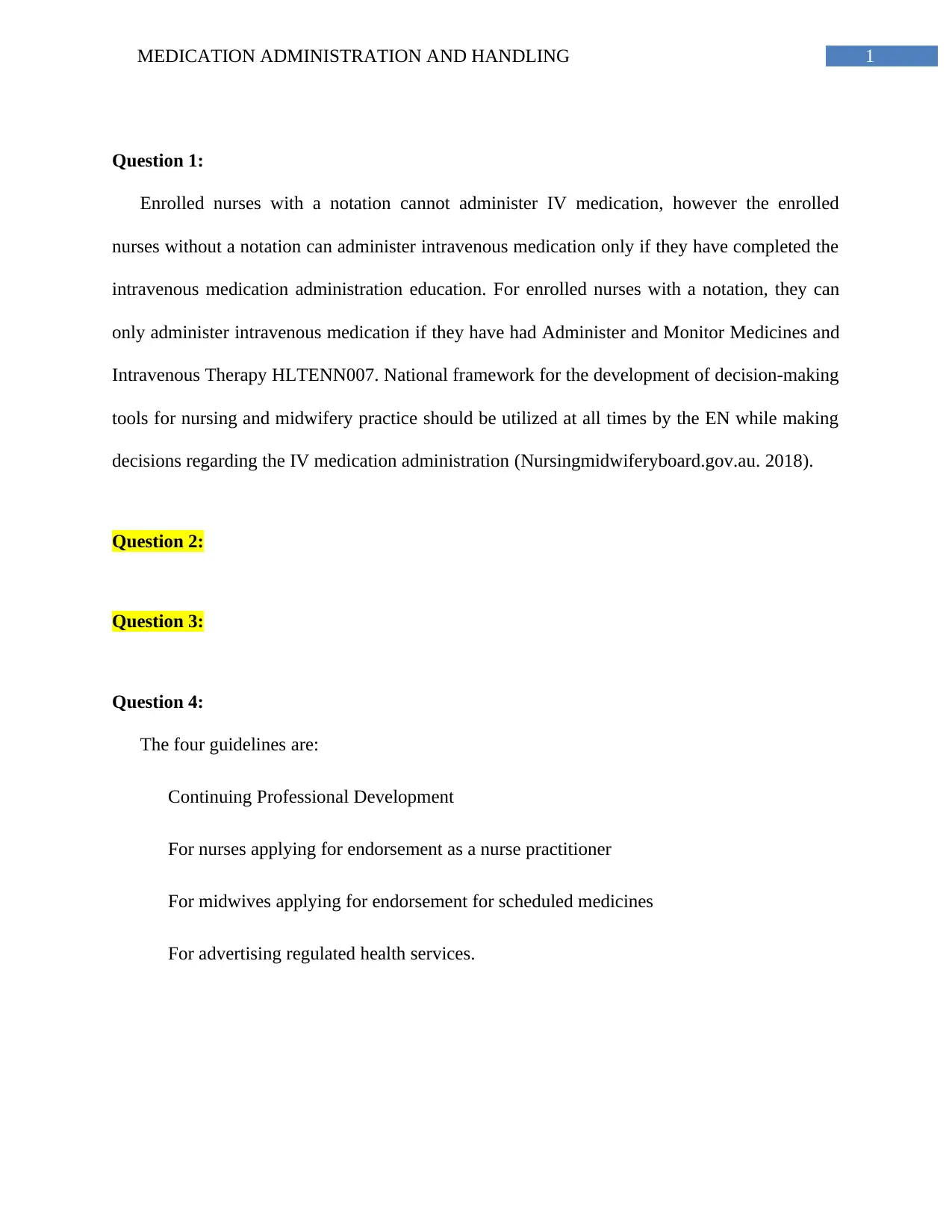
1MEDICATION ADMINISTRATION AND HANDLING
Question 1:
Enrolled nurses with a notation cannot administer IV medication, however the enrolled
nurses without a notation can administer intravenous medication only if they have completed the
intravenous medication administration education. For enrolled nurses with a notation, they can
only administer intravenous medication if they have had Administer and Monitor Medicines and
Intravenous Therapy HLTENN007. National framework for the development of decision-making
tools for nursing and midwifery practice should be utilized at all times by the EN while making
decisions regarding the IV medication administration (Nursingmidwiferyboard.gov.au. 2018).
Question 2:
Question 3:
Question 4:
The four guidelines are:
Continuing Professional Development
For nurses applying for endorsement as a nurse practitioner
For midwives applying for endorsement for scheduled medicines
For advertising regulated health services.
Question 1:
Enrolled nurses with a notation cannot administer IV medication, however the enrolled
nurses without a notation can administer intravenous medication only if they have completed the
intravenous medication administration education. For enrolled nurses with a notation, they can
only administer intravenous medication if they have had Administer and Monitor Medicines and
Intravenous Therapy HLTENN007. National framework for the development of decision-making
tools for nursing and midwifery practice should be utilized at all times by the EN while making
decisions regarding the IV medication administration (Nursingmidwiferyboard.gov.au. 2018).
Question 2:
Question 3:
Question 4:
The four guidelines are:
Continuing Professional Development
For nurses applying for endorsement as a nurse practitioner
For midwives applying for endorsement for scheduled medicines
For advertising regulated health services.
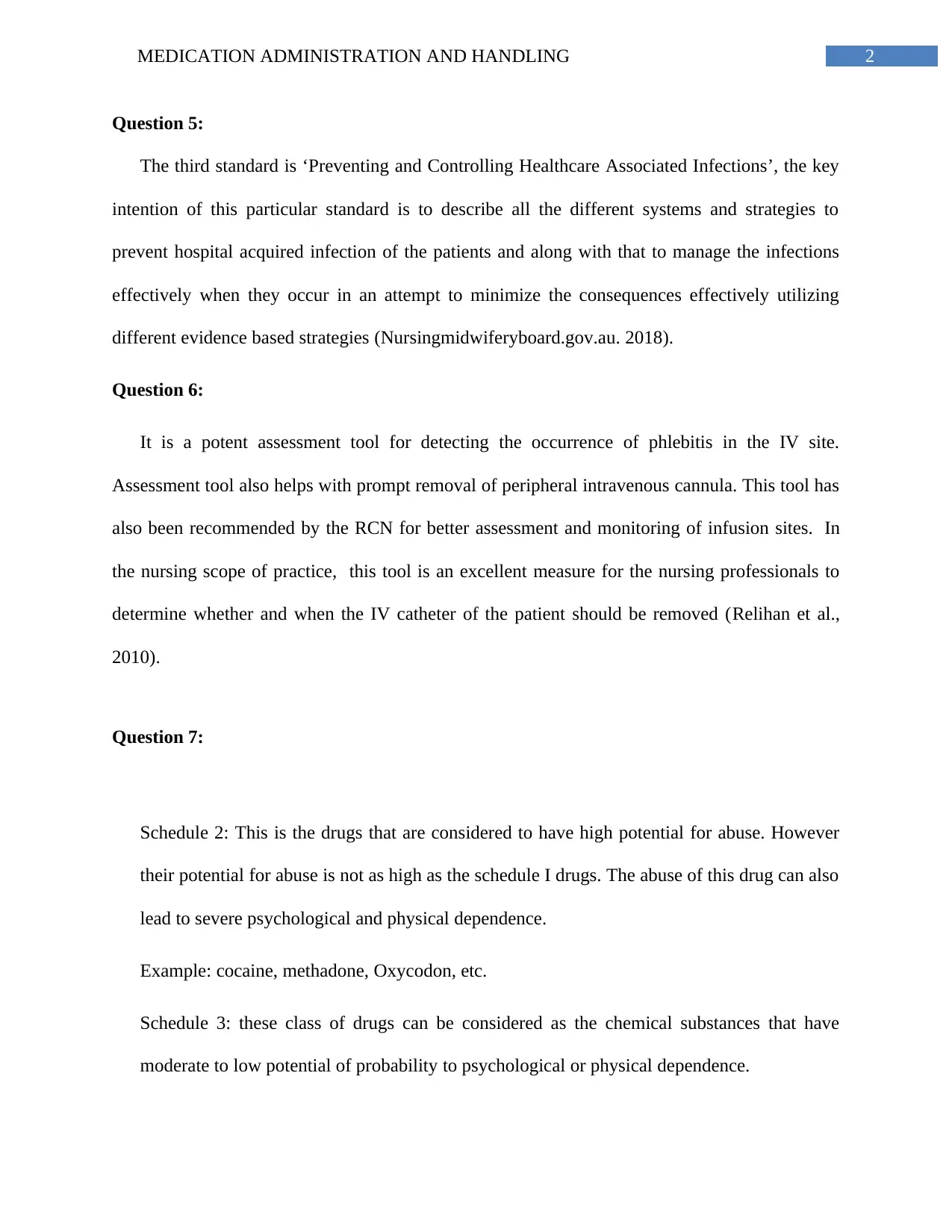
2MEDICATION ADMINISTRATION AND HANDLING
Question 5:
The third standard is ‘Preventing and Controlling Healthcare Associated Infections’, the key
intention of this particular standard is to describe all the different systems and strategies to
prevent hospital acquired infection of the patients and along with that to manage the infections
effectively when they occur in an attempt to minimize the consequences effectively utilizing
different evidence based strategies (Nursingmidwiferyboard.gov.au. 2018).
Question 6:
It is a potent assessment tool for detecting the occurrence of phlebitis in the IV site.
Assessment tool also helps with prompt removal of peripheral intravenous cannula. This tool has
also been recommended by the RCN for better assessment and monitoring of infusion sites. In
the nursing scope of practice, this tool is an excellent measure for the nursing professionals to
determine whether and when the IV catheter of the patient should be removed (Relihan et al.,
2010).
Question 7:
Schedule 2: This is the drugs that are considered to have high potential for abuse. However
their potential for abuse is not as high as the schedule I drugs. The abuse of this drug can also
lead to severe psychological and physical dependence.
Example: cocaine, methadone, Oxycodon, etc.
Schedule 3: these class of drugs can be considered as the chemical substances that have
moderate to low potential of probability to psychological or physical dependence.
Question 5:
The third standard is ‘Preventing and Controlling Healthcare Associated Infections’, the key
intention of this particular standard is to describe all the different systems and strategies to
prevent hospital acquired infection of the patients and along with that to manage the infections
effectively when they occur in an attempt to minimize the consequences effectively utilizing
different evidence based strategies (Nursingmidwiferyboard.gov.au. 2018).
Question 6:
It is a potent assessment tool for detecting the occurrence of phlebitis in the IV site.
Assessment tool also helps with prompt removal of peripheral intravenous cannula. This tool has
also been recommended by the RCN for better assessment and monitoring of infusion sites. In
the nursing scope of practice, this tool is an excellent measure for the nursing professionals to
determine whether and when the IV catheter of the patient should be removed (Relihan et al.,
2010).
Question 7:
Schedule 2: This is the drugs that are considered to have high potential for abuse. However
their potential for abuse is not as high as the schedule I drugs. The abuse of this drug can also
lead to severe psychological and physical dependence.
Example: cocaine, methadone, Oxycodon, etc.
Schedule 3: these class of drugs can be considered as the chemical substances that have
moderate to low potential of probability to psychological or physical dependence.
⊘ This is a preview!⊘
Do you want full access?
Subscribe today to unlock all pages.

Trusted by 1+ million students worldwide
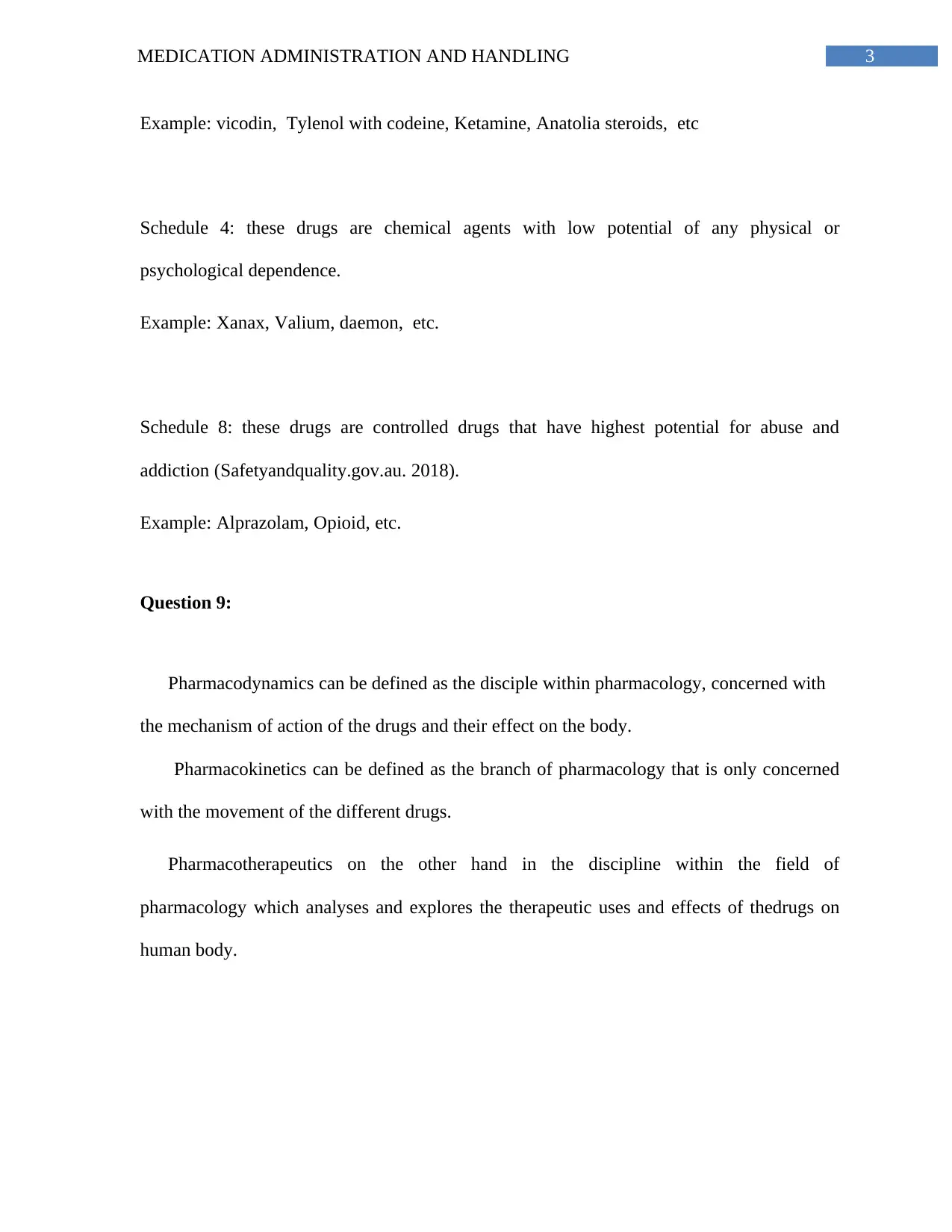
3MEDICATION ADMINISTRATION AND HANDLING
Example: vicodin, Tylenol with codeine, Ketamine, Anatolia steroids, etc
Schedule 4: these drugs are chemical agents with low potential of any physical or
psychological dependence.
Example: Xanax, Valium, daemon, etc.
Schedule 8: these drugs are controlled drugs that have highest potential for abuse and
addiction (Safetyandquality.gov.au. 2018).
Example: Alprazolam, Opioid, etc.
Question 9:
Pharmacodynamics can be defined as the disciple within pharmacology, concerned with
the mechanism of action of the drugs and their effect on the body.
Pharmacokinetics can be defined as the branch of pharmacology that is only concerned
with the movement of the different drugs.
Pharmacotherapeutics on the other hand in the discipline within the field of
pharmacology which analyses and explores the therapeutic uses and effects of thedrugs on
human body.
Example: vicodin, Tylenol with codeine, Ketamine, Anatolia steroids, etc
Schedule 4: these drugs are chemical agents with low potential of any physical or
psychological dependence.
Example: Xanax, Valium, daemon, etc.
Schedule 8: these drugs are controlled drugs that have highest potential for abuse and
addiction (Safetyandquality.gov.au. 2018).
Example: Alprazolam, Opioid, etc.
Question 9:
Pharmacodynamics can be defined as the disciple within pharmacology, concerned with
the mechanism of action of the drugs and their effect on the body.
Pharmacokinetics can be defined as the branch of pharmacology that is only concerned
with the movement of the different drugs.
Pharmacotherapeutics on the other hand in the discipline within the field of
pharmacology which analyses and explores the therapeutic uses and effects of thedrugs on
human body.
Paraphrase This Document
Need a fresh take? Get an instant paraphrase of this document with our AI Paraphraser
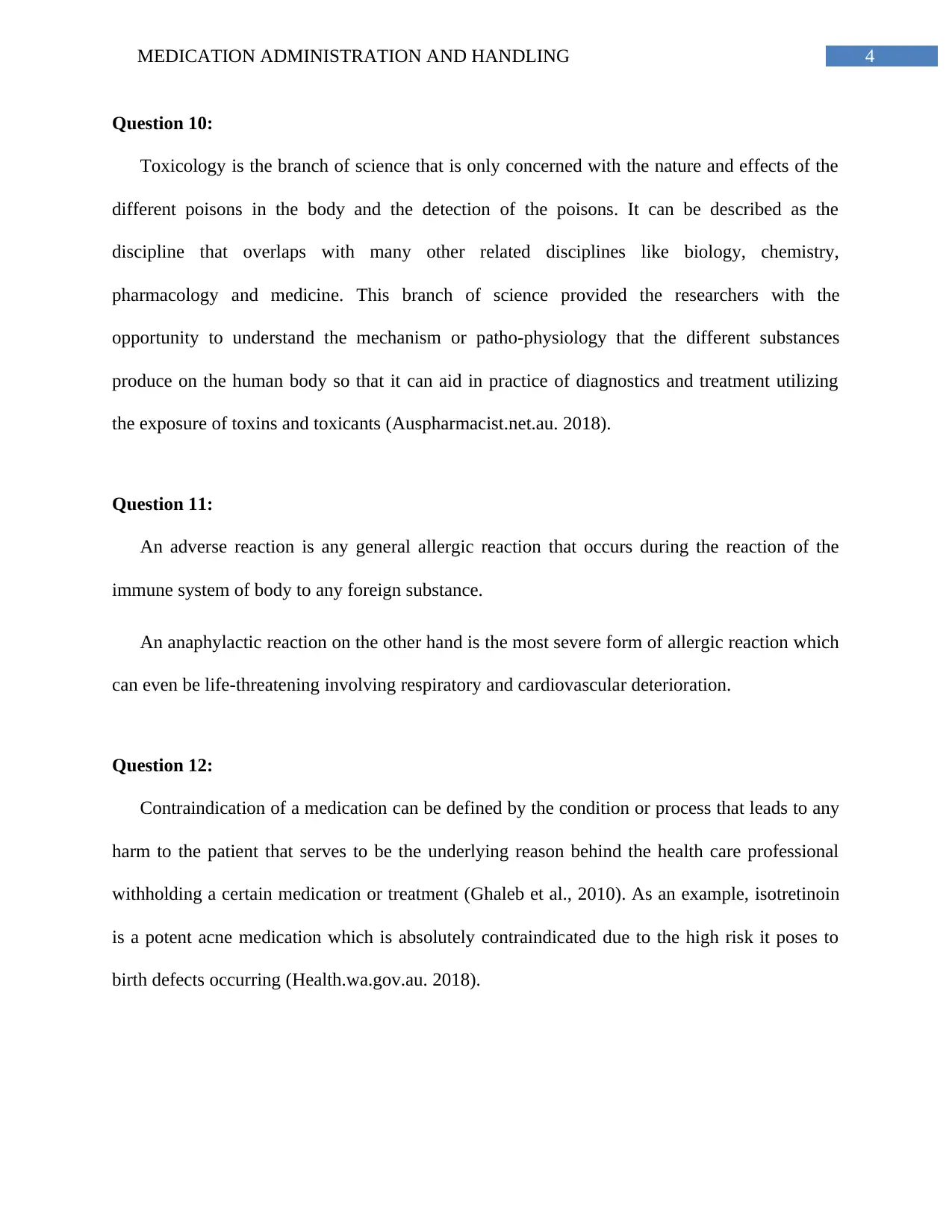
4MEDICATION ADMINISTRATION AND HANDLING
Question 10:
Toxicology is the branch of science that is only concerned with the nature and effects of the
different poisons in the body and the detection of the poisons. It can be described as the
discipline that overlaps with many other related disciplines like biology, chemistry,
pharmacology and medicine. This branch of science provided the researchers with the
opportunity to understand the mechanism or patho-physiology that the different substances
produce on the human body so that it can aid in practice of diagnostics and treatment utilizing
the exposure of toxins and toxicants (Auspharmacist.net.au. 2018).
Question 11:
An adverse reaction is any general allergic reaction that occurs during the reaction of the
immune system of body to any foreign substance.
An anaphylactic reaction on the other hand is the most severe form of allergic reaction which
can even be life-threatening involving respiratory and cardiovascular deterioration.
Question 12:
Contraindication of a medication can be defined by the condition or process that leads to any
harm to the patient that serves to be the underlying reason behind the health care professional
withholding a certain medication or treatment (Ghaleb et al., 2010). As an example, isotretinoin
is a potent acne medication which is absolutely contraindicated due to the high risk it poses to
birth defects occurring (Health.wa.gov.au. 2018).
Question 10:
Toxicology is the branch of science that is only concerned with the nature and effects of the
different poisons in the body and the detection of the poisons. It can be described as the
discipline that overlaps with many other related disciplines like biology, chemistry,
pharmacology and medicine. This branch of science provided the researchers with the
opportunity to understand the mechanism or patho-physiology that the different substances
produce on the human body so that it can aid in practice of diagnostics and treatment utilizing
the exposure of toxins and toxicants (Auspharmacist.net.au. 2018).
Question 11:
An adverse reaction is any general allergic reaction that occurs during the reaction of the
immune system of body to any foreign substance.
An anaphylactic reaction on the other hand is the most severe form of allergic reaction which
can even be life-threatening involving respiratory and cardiovascular deterioration.
Question 12:
Contraindication of a medication can be defined by the condition or process that leads to any
harm to the patient that serves to be the underlying reason behind the health care professional
withholding a certain medication or treatment (Ghaleb et al., 2010). As an example, isotretinoin
is a potent acne medication which is absolutely contraindicated due to the high risk it poses to
birth defects occurring (Health.wa.gov.au. 2018).
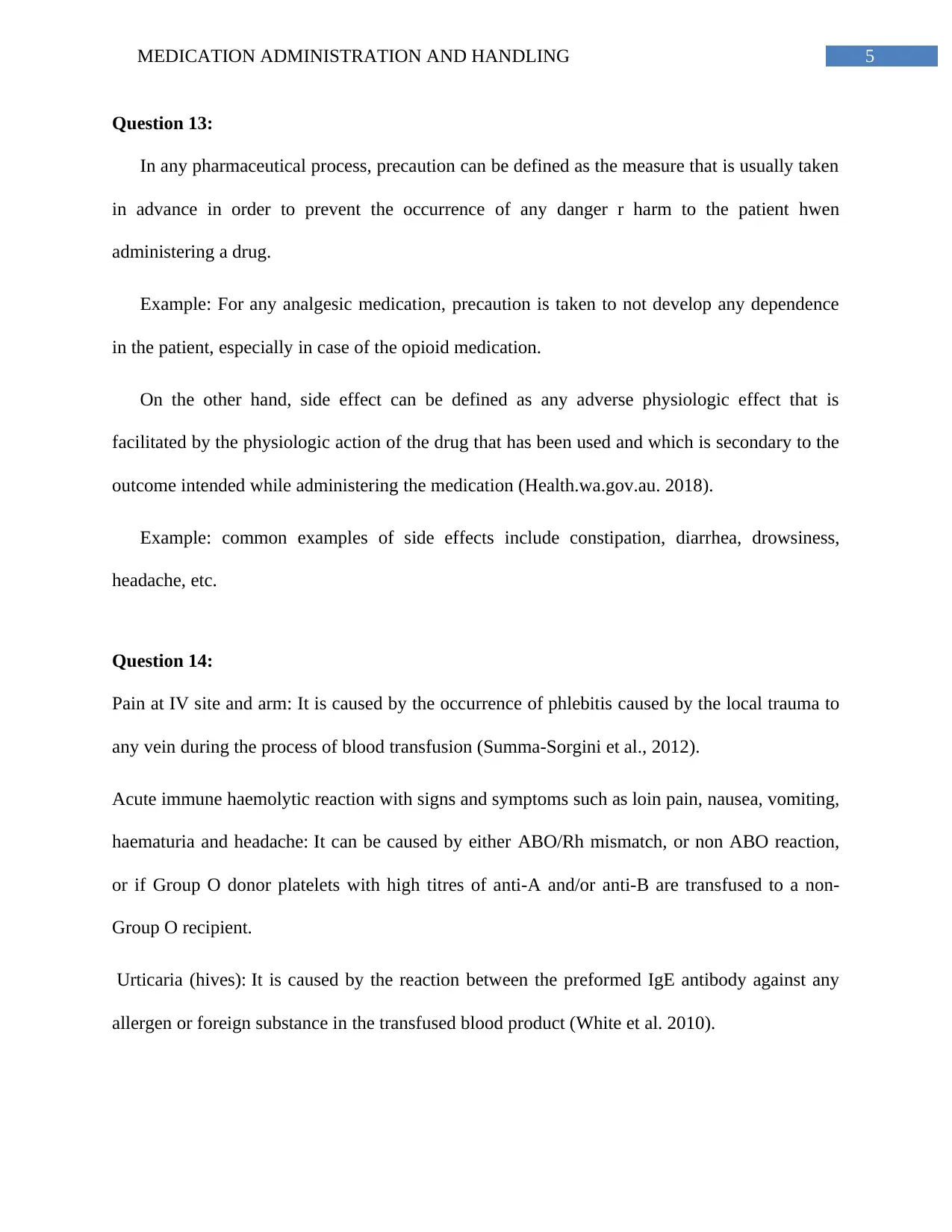
5MEDICATION ADMINISTRATION AND HANDLING
Question 13:
In any pharmaceutical process, precaution can be defined as the measure that is usually taken
in advance in order to prevent the occurrence of any danger r harm to the patient hwen
administering a drug.
Example: For any analgesic medication, precaution is taken to not develop any dependence
in the patient, especially in case of the opioid medication.
On the other hand, side effect can be defined as any adverse physiologic effect that is
facilitated by the physiologic action of the drug that has been used and which is secondary to the
outcome intended while administering the medication (Health.wa.gov.au. 2018).
Example: common examples of side effects include constipation, diarrhea, drowsiness,
headache, etc.
Question 14:
Pain at IV site and arm: It is caused by the occurrence of phlebitis caused by the local trauma to
any vein during the process of blood transfusion (Summa-Sorgini et al., 2012).
Acute immune haemolytic reaction with signs and symptoms such as loin pain, nausea, vomiting,
haematuria and headache: It can be caused by either ABO/Rh mismatch, or non ABO reaction,
or if Group O donor platelets with high titres of anti-A and/or anti-B are transfused to a non-
Group O recipient.
Urticaria (hives): It is caused by the reaction between the preformed IgE antibody against any
allergen or foreign substance in the transfused blood product (White et al. 2010).
Question 13:
In any pharmaceutical process, precaution can be defined as the measure that is usually taken
in advance in order to prevent the occurrence of any danger r harm to the patient hwen
administering a drug.
Example: For any analgesic medication, precaution is taken to not develop any dependence
in the patient, especially in case of the opioid medication.
On the other hand, side effect can be defined as any adverse physiologic effect that is
facilitated by the physiologic action of the drug that has been used and which is secondary to the
outcome intended while administering the medication (Health.wa.gov.au. 2018).
Example: common examples of side effects include constipation, diarrhea, drowsiness,
headache, etc.
Question 14:
Pain at IV site and arm: It is caused by the occurrence of phlebitis caused by the local trauma to
any vein during the process of blood transfusion (Summa-Sorgini et al., 2012).
Acute immune haemolytic reaction with signs and symptoms such as loin pain, nausea, vomiting,
haematuria and headache: It can be caused by either ABO/Rh mismatch, or non ABO reaction,
or if Group O donor platelets with high titres of anti-A and/or anti-B are transfused to a non-
Group O recipient.
Urticaria (hives): It is caused by the reaction between the preformed IgE antibody against any
allergen or foreign substance in the transfused blood product (White et al. 2010).
⊘ This is a preview!⊘
Do you want full access?
Subscribe today to unlock all pages.

Trusted by 1+ million students worldwide
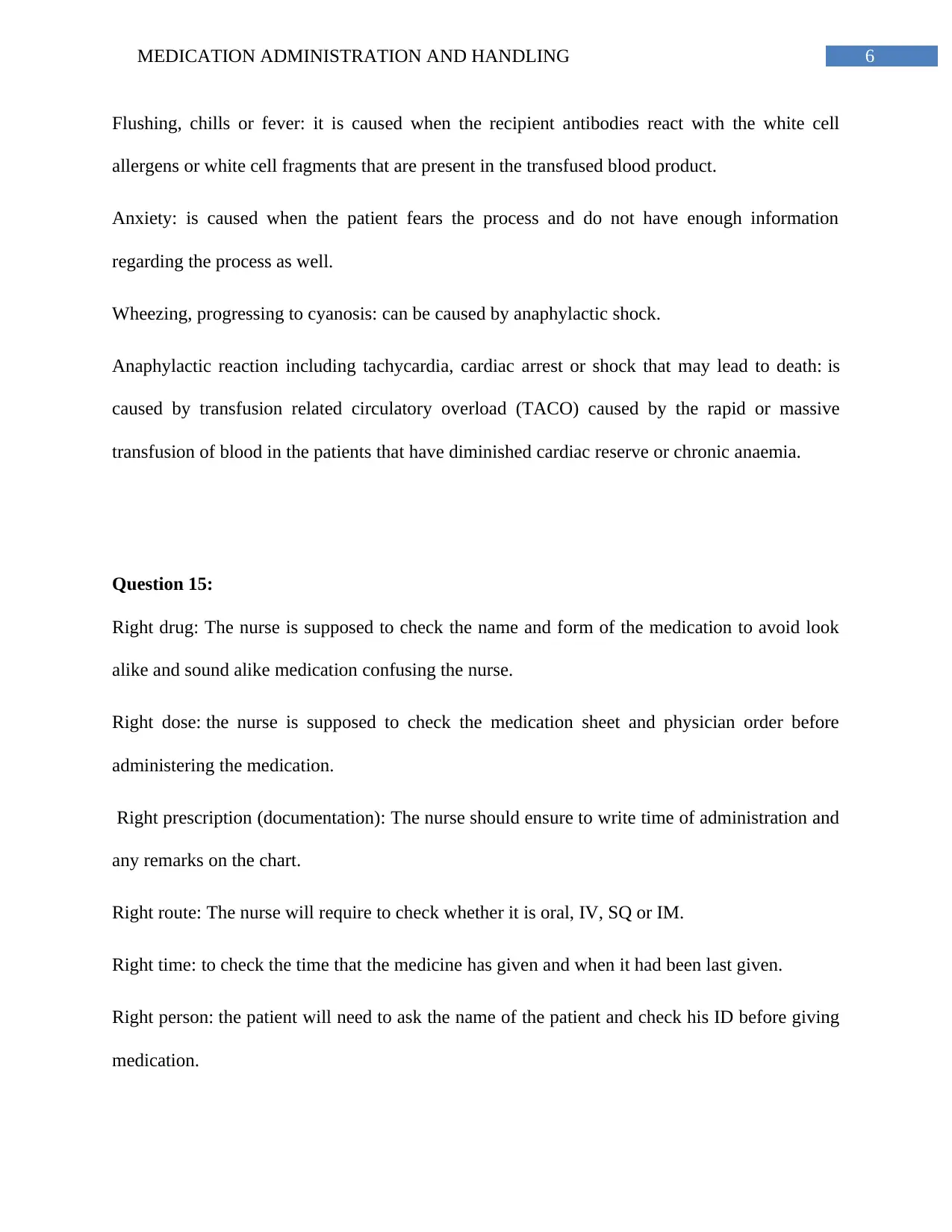
6MEDICATION ADMINISTRATION AND HANDLING
Flushing, chills or fever: it is caused when the recipient antibodies react with the white cell
allergens or white cell fragments that are present in the transfused blood product.
Anxiety: is caused when the patient fears the process and do not have enough information
regarding the process as well.
Wheezing, progressing to cyanosis: can be caused by anaphylactic shock.
Anaphylactic reaction including tachycardia, cardiac arrest or shock that may lead to death: is
caused by transfusion related circulatory overload (TACO) caused by the rapid or massive
transfusion of blood in the patients that have diminished cardiac reserve or chronic anaemia.
Question 15:
Right drug: The nurse is supposed to check the name and form of the medication to avoid look
alike and sound alike medication confusing the nurse.
Right dose: the nurse is supposed to check the medication sheet and physician order before
administering the medication.
Right prescription (documentation): The nurse should ensure to write time of administration and
any remarks on the chart.
Right route: The nurse will require to check whether it is oral, IV, SQ or IM.
Right time: to check the time that the medicine has given and when it had been last given.
Right person: the patient will need to ask the name of the patient and check his ID before giving
medication.
Flushing, chills or fever: it is caused when the recipient antibodies react with the white cell
allergens or white cell fragments that are present in the transfused blood product.
Anxiety: is caused when the patient fears the process and do not have enough information
regarding the process as well.
Wheezing, progressing to cyanosis: can be caused by anaphylactic shock.
Anaphylactic reaction including tachycardia, cardiac arrest or shock that may lead to death: is
caused by transfusion related circulatory overload (TACO) caused by the rapid or massive
transfusion of blood in the patients that have diminished cardiac reserve or chronic anaemia.
Question 15:
Right drug: The nurse is supposed to check the name and form of the medication to avoid look
alike and sound alike medication confusing the nurse.
Right dose: the nurse is supposed to check the medication sheet and physician order before
administering the medication.
Right prescription (documentation): The nurse should ensure to write time of administration and
any remarks on the chart.
Right route: The nurse will require to check whether it is oral, IV, SQ or IM.
Right time: to check the time that the medicine has given and when it had been last given.
Right person: the patient will need to ask the name of the patient and check his ID before giving
medication.
Paraphrase This Document
Need a fresh take? Get an instant paraphrase of this document with our AI Paraphraser
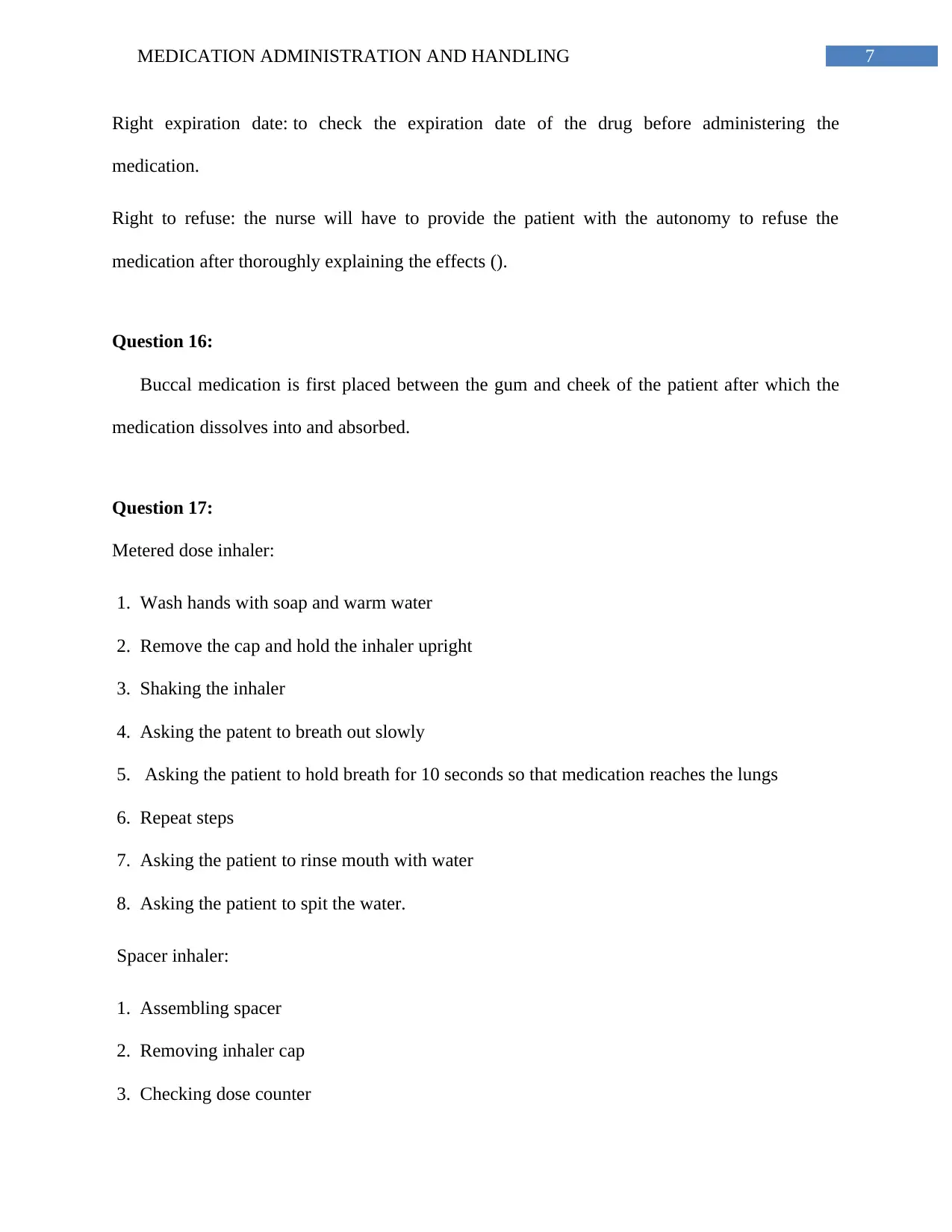
7MEDICATION ADMINISTRATION AND HANDLING
Right expiration date: to check the expiration date of the drug before administering the
medication.
Right to refuse: the nurse will have to provide the patient with the autonomy to refuse the
medication after thoroughly explaining the effects ().
Question 16:
Buccal medication is first placed between the gum and cheek of the patient after which the
medication dissolves into and absorbed.
Question 17:
Metered dose inhaler:
1. Wash hands with soap and warm water
2. Remove the cap and hold the inhaler upright
3. Shaking the inhaler
4. Asking the patent to breath out slowly
5. Asking the patient to hold breath for 10 seconds so that medication reaches the lungs
6. Repeat steps
7. Asking the patient to rinse mouth with water
8. Asking the patient to spit the water.
Spacer inhaler:
1. Assembling spacer
2. Removing inhaler cap
3. Checking dose counter
Right expiration date: to check the expiration date of the drug before administering the
medication.
Right to refuse: the nurse will have to provide the patient with the autonomy to refuse the
medication after thoroughly explaining the effects ().
Question 16:
Buccal medication is first placed between the gum and cheek of the patient after which the
medication dissolves into and absorbed.
Question 17:
Metered dose inhaler:
1. Wash hands with soap and warm water
2. Remove the cap and hold the inhaler upright
3. Shaking the inhaler
4. Asking the patent to breath out slowly
5. Asking the patient to hold breath for 10 seconds so that medication reaches the lungs
6. Repeat steps
7. Asking the patient to rinse mouth with water
8. Asking the patient to spit the water.
Spacer inhaler:
1. Assembling spacer
2. Removing inhaler cap
3. Checking dose counter
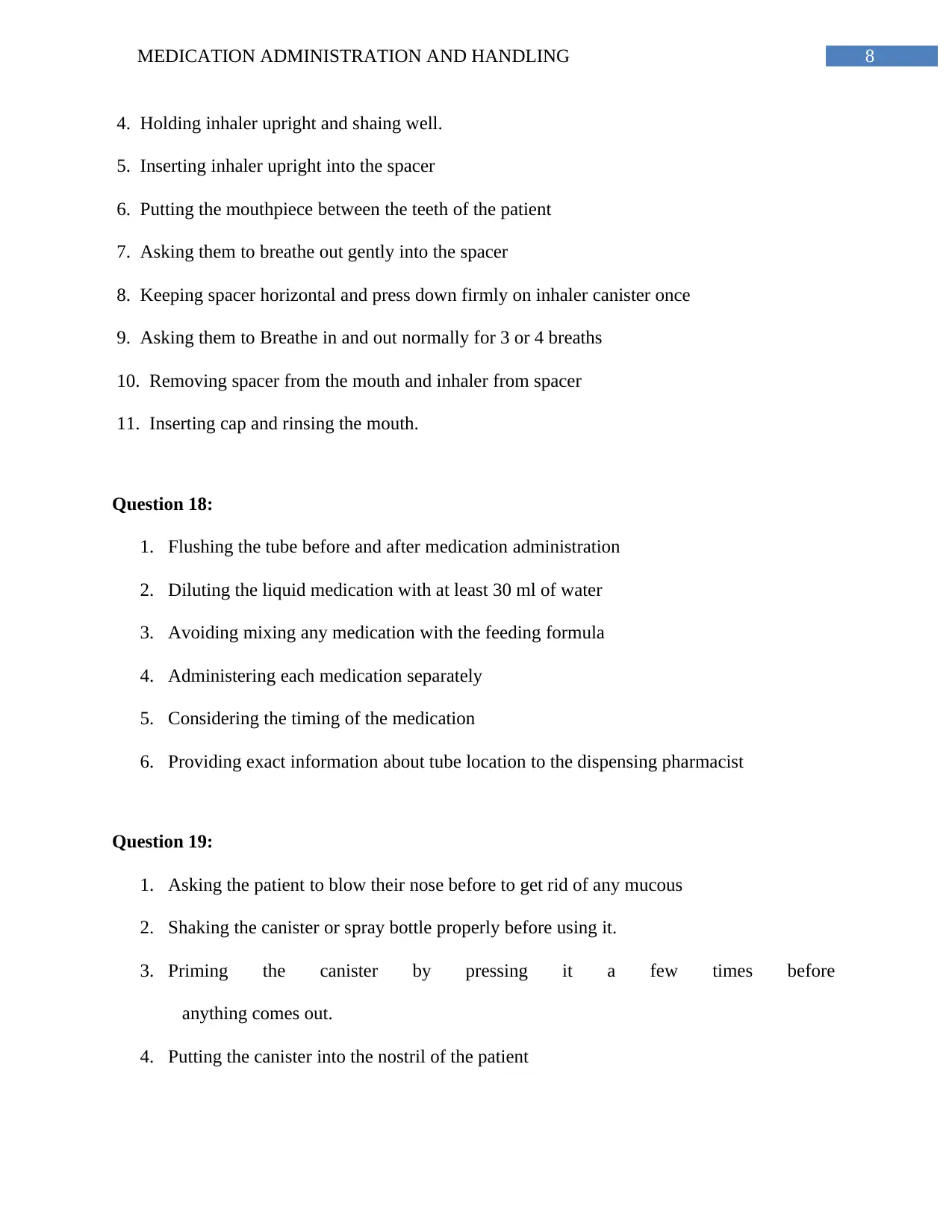
8MEDICATION ADMINISTRATION AND HANDLING
4. Holding inhaler upright and shaing well.
5. Inserting inhaler upright into the spacer
6. Putting the mouthpiece between the teeth of the patient
7. Asking them to breathe out gently into the spacer
8. Keeping spacer horizontal and press down firmly on inhaler canister once
9. Asking them to Breathe in and out normally for 3 or 4 breaths
10. Removing spacer from the mouth and inhaler from spacer
11. Inserting cap and rinsing the mouth.
Question 18:
1. Flushing the tube before and after medication administration
2. Diluting the liquid medication with at least 30 ml of water
3. Avoiding mixing any medication with the feeding formula
4. Administering each medication separately
5. Considering the timing of the medication
6. Providing exact information about tube location to the dispensing pharmacist
Question 19:
1. Asking the patient to blow their nose before to get rid of any mucous
2. Shaking the canister or spray bottle properly before using it.
3. Priming the canister by pressing it a few times before
anything comes out.
4. Putting the canister into the nostril of the patient
4. Holding inhaler upright and shaing well.
5. Inserting inhaler upright into the spacer
6. Putting the mouthpiece between the teeth of the patient
7. Asking them to breathe out gently into the spacer
8. Keeping spacer horizontal and press down firmly on inhaler canister once
9. Asking them to Breathe in and out normally for 3 or 4 breaths
10. Removing spacer from the mouth and inhaler from spacer
11. Inserting cap and rinsing the mouth.
Question 18:
1. Flushing the tube before and after medication administration
2. Diluting the liquid medication with at least 30 ml of water
3. Avoiding mixing any medication with the feeding formula
4. Administering each medication separately
5. Considering the timing of the medication
6. Providing exact information about tube location to the dispensing pharmacist
Question 19:
1. Asking the patient to blow their nose before to get rid of any mucous
2. Shaking the canister or spray bottle properly before using it.
3. Priming the canister by pressing it a few times before
anything comes out.
4. Putting the canister into the nostril of the patient
⊘ This is a preview!⊘
Do you want full access?
Subscribe today to unlock all pages.

Trusted by 1+ million students worldwide
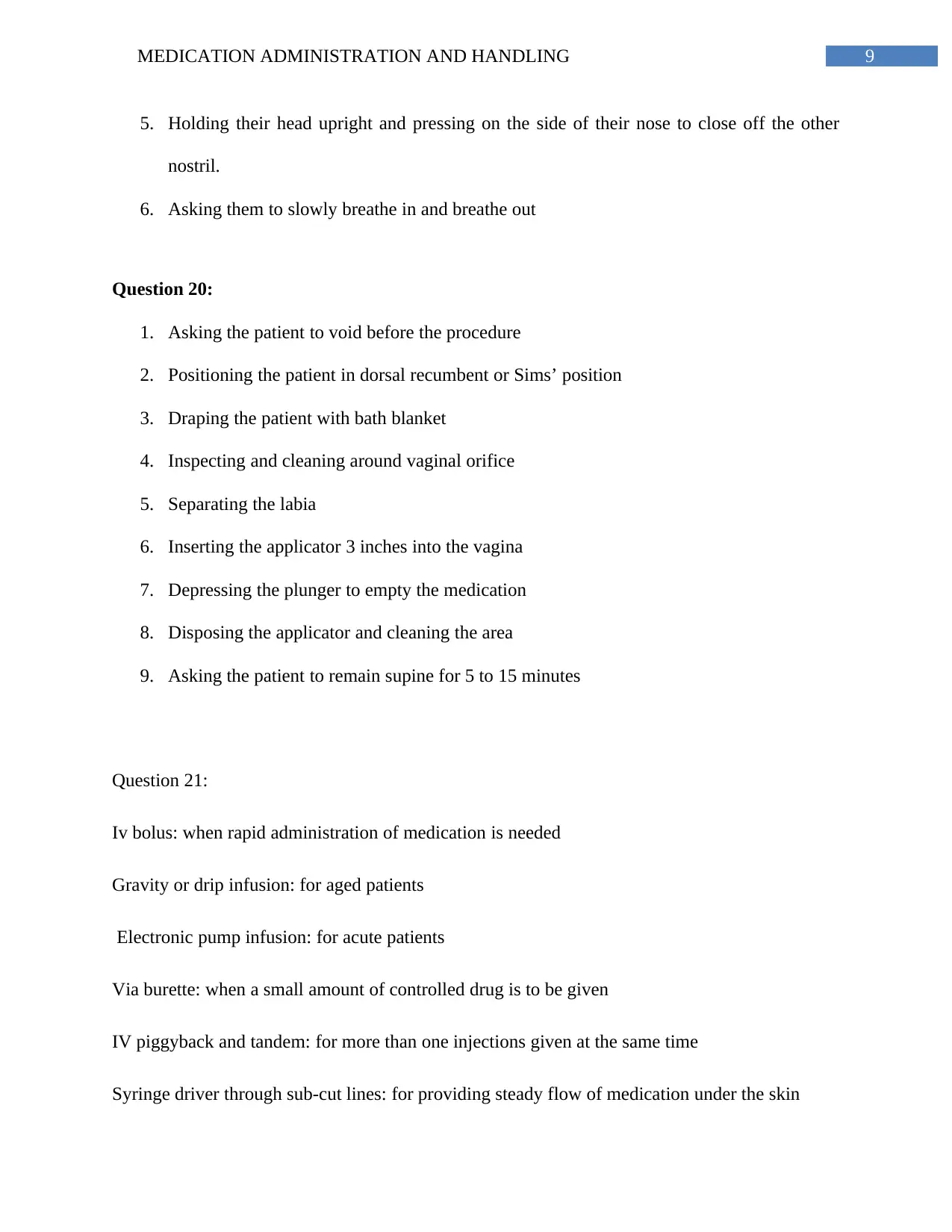
9MEDICATION ADMINISTRATION AND HANDLING
5. Holding their head upright and pressing on the side of their nose to close off the other
nostril.
6. Asking them to slowly breathe in and breathe out
Question 20:
1. Asking the patient to void before the procedure
2. Positioning the patient in dorsal recumbent or Sims’ position
3. Draping the patient with bath blanket
4. Inspecting and cleaning around vaginal orifice
5. Separating the labia
6. Inserting the applicator 3 inches into the vagina
7. Depressing the plunger to empty the medication
8. Disposing the applicator and cleaning the area
9. Asking the patient to remain supine for 5 to 15 minutes
Question 21:
Iv bolus: when rapid administration of medication is needed
Gravity or drip infusion: for aged patients
Electronic pump infusion: for acute patients
Via burette: when a small amount of controlled drug is to be given
IV piggyback and tandem: for more than one injections given at the same time
Syringe driver through sub-cut lines: for providing steady flow of medication under the skin
5. Holding their head upright and pressing on the side of their nose to close off the other
nostril.
6. Asking them to slowly breathe in and breathe out
Question 20:
1. Asking the patient to void before the procedure
2. Positioning the patient in dorsal recumbent or Sims’ position
3. Draping the patient with bath blanket
4. Inspecting and cleaning around vaginal orifice
5. Separating the labia
6. Inserting the applicator 3 inches into the vagina
7. Depressing the plunger to empty the medication
8. Disposing the applicator and cleaning the area
9. Asking the patient to remain supine for 5 to 15 minutes
Question 21:
Iv bolus: when rapid administration of medication is needed
Gravity or drip infusion: for aged patients
Electronic pump infusion: for acute patients
Via burette: when a small amount of controlled drug is to be given
IV piggyback and tandem: for more than one injections given at the same time
Syringe driver through sub-cut lines: for providing steady flow of medication under the skin
Paraphrase This Document
Need a fresh take? Get an instant paraphrase of this document with our AI Paraphraser
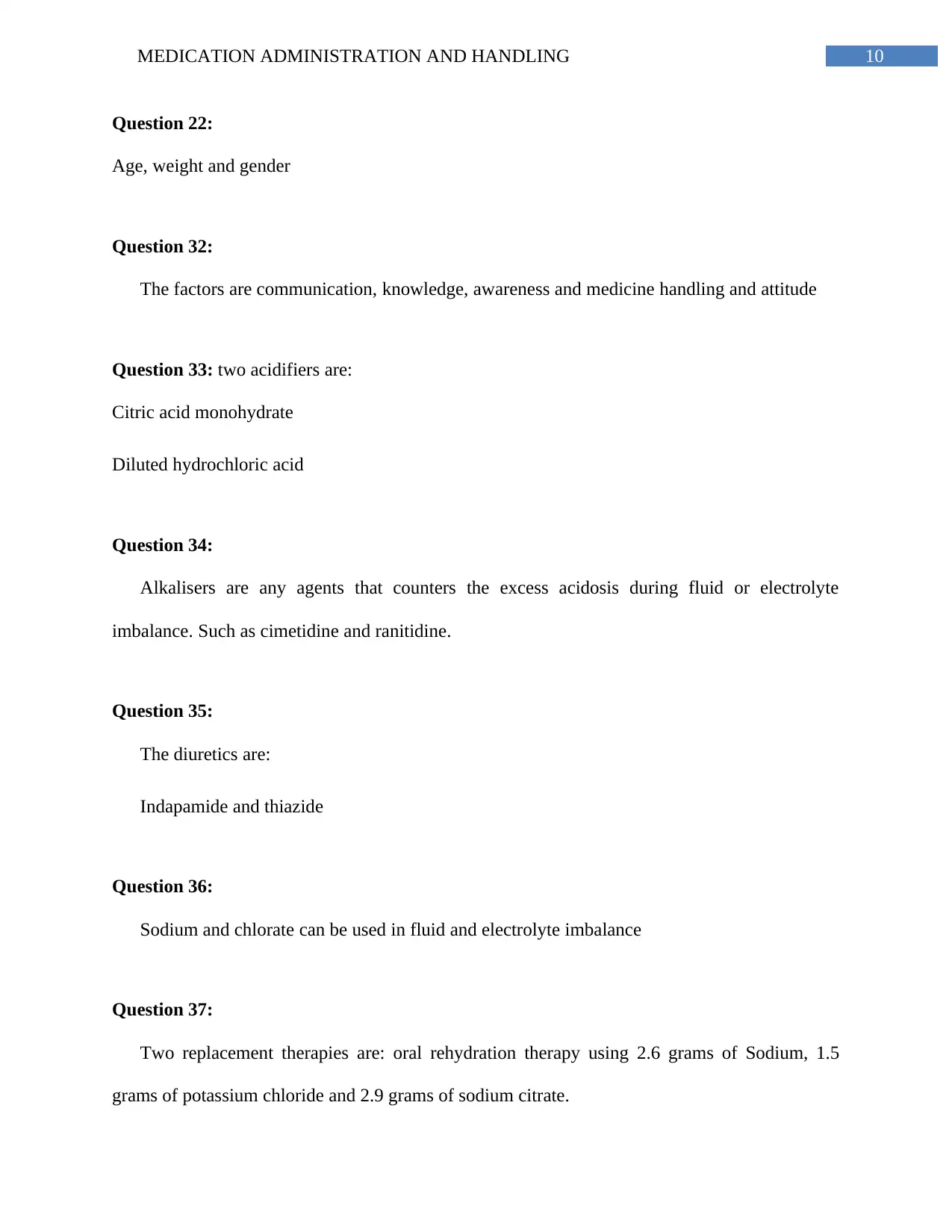
10MEDICATION ADMINISTRATION AND HANDLING
Question 22:
Age, weight and gender
Question 32:
The factors are communication, knowledge, awareness and medicine handling and attitude
Question 33: two acidifiers are:
Citric acid monohydrate
Diluted hydrochloric acid
Question 34:
Alkalisers are any agents that counters the excess acidosis during fluid or electrolyte
imbalance. Such as cimetidine and ranitidine.
Question 35:
The diuretics are:
Indapamide and thiazide
Question 36:
Sodium and chlorate can be used in fluid and electrolyte imbalance
Question 37:
Two replacement therapies are: oral rehydration therapy using 2.6 grams of Sodium, 1.5
grams of potassium chloride and 2.9 grams of sodium citrate.
Question 22:
Age, weight and gender
Question 32:
The factors are communication, knowledge, awareness and medicine handling and attitude
Question 33: two acidifiers are:
Citric acid monohydrate
Diluted hydrochloric acid
Question 34:
Alkalisers are any agents that counters the excess acidosis during fluid or electrolyte
imbalance. Such as cimetidine and ranitidine.
Question 35:
The diuretics are:
Indapamide and thiazide
Question 36:
Sodium and chlorate can be used in fluid and electrolyte imbalance
Question 37:
Two replacement therapies are: oral rehydration therapy using 2.6 grams of Sodium, 1.5
grams of potassium chloride and 2.9 grams of sodium citrate.
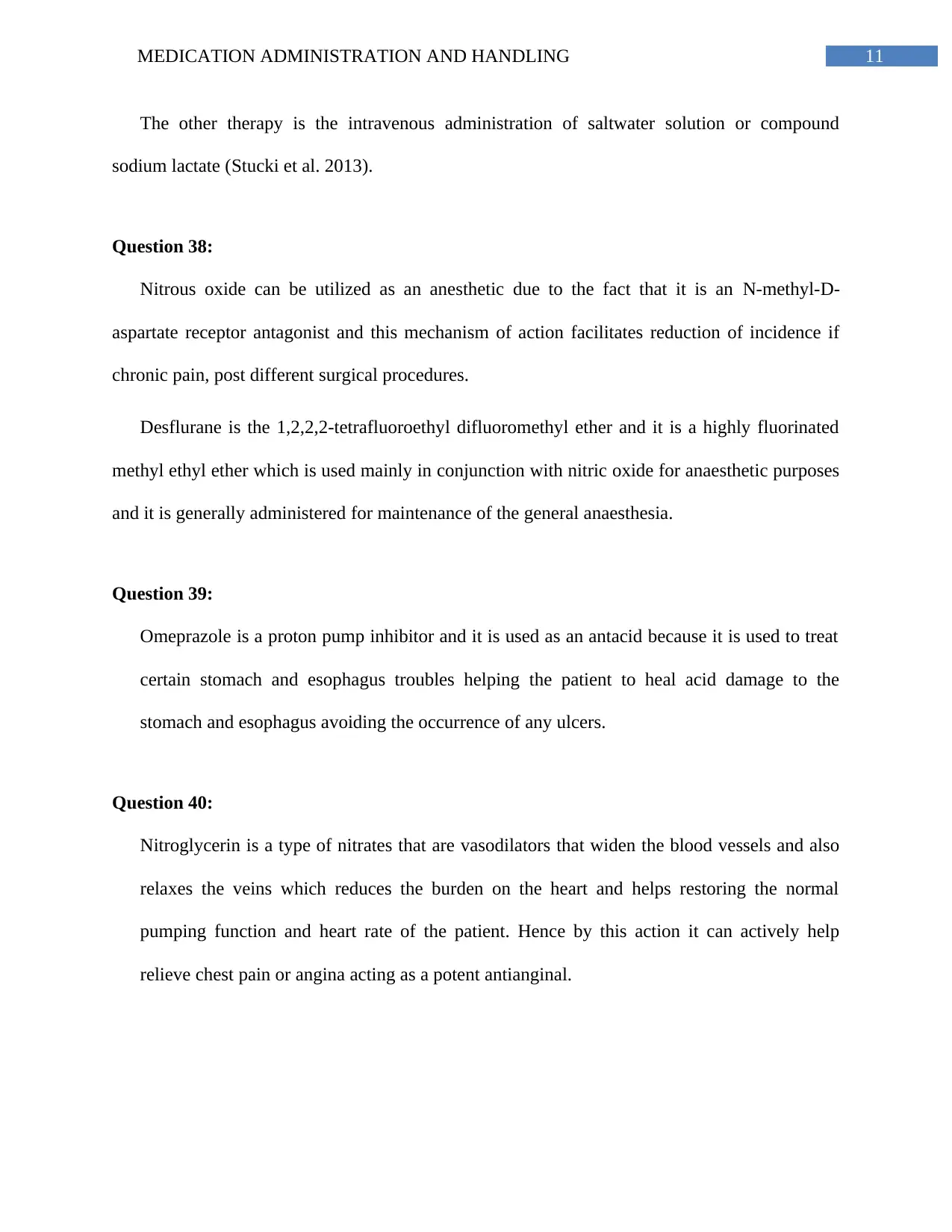
11MEDICATION ADMINISTRATION AND HANDLING
The other therapy is the intravenous administration of saltwater solution or compound
sodium lactate (Stucki et al. 2013).
Question 38:
Nitrous oxide can be utilized as an anesthetic due to the fact that it is an N-methyl-D-
aspartate receptor antagonist and this mechanism of action facilitates reduction of incidence if
chronic pain, post different surgical procedures.
Desflurane is the 1,2,2,2-tetrafluoroethyl difluoromethyl ether and it is a highly fluorinated
methyl ethyl ether which is used mainly in conjunction with nitric oxide for anaesthetic purposes
and it is generally administered for maintenance of the general anaesthesia.
Question 39:
Omeprazole is a proton pump inhibitor and it is used as an antacid because it is used to treat
certain stomach and esophagus troubles helping the patient to heal acid damage to the
stomach and esophagus avoiding the occurrence of any ulcers.
Question 40:
Nitroglycerin is a type of nitrates that are vasodilators that widen the blood vessels and also
relaxes the veins which reduces the burden on the heart and helps restoring the normal
pumping function and heart rate of the patient. Hence by this action it can actively help
relieve chest pain or angina acting as a potent antianginal.
The other therapy is the intravenous administration of saltwater solution or compound
sodium lactate (Stucki et al. 2013).
Question 38:
Nitrous oxide can be utilized as an anesthetic due to the fact that it is an N-methyl-D-
aspartate receptor antagonist and this mechanism of action facilitates reduction of incidence if
chronic pain, post different surgical procedures.
Desflurane is the 1,2,2,2-tetrafluoroethyl difluoromethyl ether and it is a highly fluorinated
methyl ethyl ether which is used mainly in conjunction with nitric oxide for anaesthetic purposes
and it is generally administered for maintenance of the general anaesthesia.
Question 39:
Omeprazole is a proton pump inhibitor and it is used as an antacid because it is used to treat
certain stomach and esophagus troubles helping the patient to heal acid damage to the
stomach and esophagus avoiding the occurrence of any ulcers.
Question 40:
Nitroglycerin is a type of nitrates that are vasodilators that widen the blood vessels and also
relaxes the veins which reduces the burden on the heart and helps restoring the normal
pumping function and heart rate of the patient. Hence by this action it can actively help
relieve chest pain or angina acting as a potent antianginal.
⊘ This is a preview!⊘
Do you want full access?
Subscribe today to unlock all pages.

Trusted by 1+ million students worldwide
1 out of 31
Related Documents
Your All-in-One AI-Powered Toolkit for Academic Success.
+13062052269
info@desklib.com
Available 24*7 on WhatsApp / Email
![[object Object]](/_next/static/media/star-bottom.7253800d.svg)
Unlock your academic potential
Copyright © 2020–2025 A2Z Services. All Rights Reserved. Developed and managed by ZUCOL.





